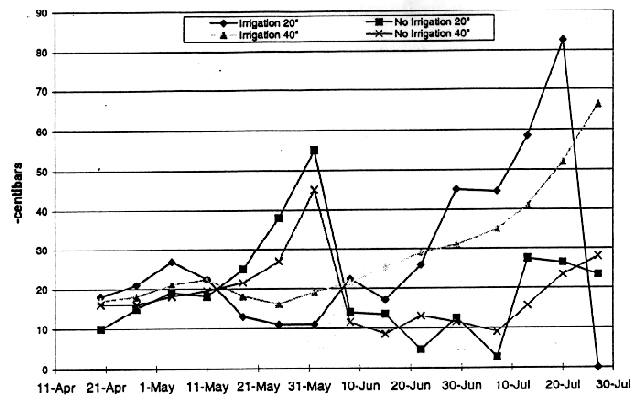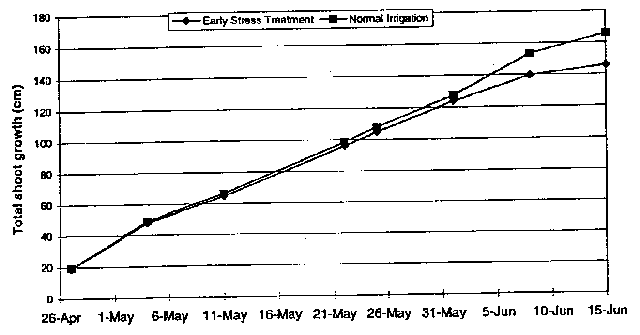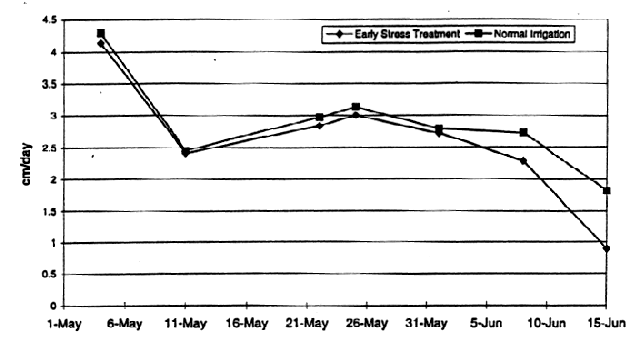Disclaimer: This article is geared towards a Tulare County
audience and may not be applicable to other geographical areas.
Reprint freely with credit to: The University
of California Cooperative Extension, Tulare County.
For more information contact: Bill Peacock, Farm Advisor, wlpeacock@ucdavis.edu
Improving Berry Set and Packable Yield
of Fantasy Seedless
Bill Peacock, Tiffanie Simpson and Brett Allen,
University of California Cooperative Extension, Tulare County
Abstract
Withholding drip irrigation until berry set, without girdling or shoot tipping,
increased packable yield by 51% and total yield (packable + culls) by 66% compared to
vines drip irrigated before berry set in daily amounts equaling evapotranspiration (E.T.).
This yield increase was greater than occurred in 1994 and can be attributed to an increase
in fruitfulness of vines not receiving irrigation before berry set in 1994.
Tipping shoots or girdling at the onset of bloom increased packable yields by 52% and
37%, respectively, when vines were irrigated. However, when irrigations were withheld
until berry set (June 2), tipping shoots or girdling at the onset of bloom increased
packable yields 89% and 86%, respectively. The combination of girdling and withholding
irrigations, however, substantially increased green berries and trimming cost, and this
combination is not recommended.
Tipping flower clusters at the onset of bloom did not increase packable yield or total
yield regardless of whether vines were irrigated before berry set or not.
Tipping shoots appears to redirect carbohydrate flux from shoots to developing fruit,
advancing maturity. This warrants further investigation with other cultivars or in growing
districts where advanced maturity is commercially advantageous. Withholding drip
irrigation lowered soil-matrix potential (tensiometer readings) at the 20" and
40" soil depths to approximately -50 centibar by berry set. When vines were drip
irrigated before berry set (in daily amounts equaling E.T.), soil-matrix potentials were
maintained at approximately -20 centibar from bud break to berry set at both the 20"
and 40" soil depths. Withholding drip irrigation resulted in a slight reduction in
total shoot growth and rate of shoot growth (inches of shoot growth per day) by berry set.
Objective
Fantasy Seedless is a mid-season, seedless black table grape developed by members of
the USDA Fruit Genetics and Breeding Research Unit, Fresno. It is a vigorous variety with
poor fruit setting characteristics, and it generally yields below capacity because of the
low proportion of flowers that set to become berries. As a result of inadequate set, some
flower clusters dry and abscise from the vine, many others are too straggly to pack, and
packable fruit and total yields are much less than the vine's capacity. Cultural
techniques to improve berry set must be developed for this variety to become commercially
viable.
Procedures
The research was conducted in a seven-year-old, very vigorous, Fantasy Seedless
vineyard planted on Exeter loam. The vineyard was drip irrigated. The trellis system
consisted of a small Y with 48 inches separating the arms and upper foliage wires and 24
inches separating the cane wires. Vines were pruned to eight canes.
The experiment was a factorial and designed as a split-plot with five blocks
(replications). Main plot treatments contained 60 vines (20 vines x 3 rows), and split
plots contained fifteen vines (five vines x 3 rows). Main and split plot treatments were
as follows:
Main plot treatments:
1) Standard Drip Irrigation: Daily drip irrigation applied beginning April 15 in
amounts that equaled daily vine water use, evapotranspiration.
2) Withhold Drip Irrigations: No irrigation until June 2 when berries averaged 4.5 mm
diameter; then, 2 inches of water was applied to catch up with the standard irrigation
treatment.
Split plot treatments:
1) Control.
2) Vines girdled May 15 (5% bloom).
3) Flower clusters were tipped May 15 by pinching off about an inch from the bottom of
every flower cluster.
4) Shoots were tipped May 15 by pinching off about two to three inches from the tip of
every shoot on the vine.
Soil, water, and plant relationships were evaluated as follows. Soil-water matrix
potential was measured weekly with tensiometers placed at 20" and 40" depths.
Shoot growth was monitored by measuring the distance from a tag to the shoot tip on a
weekly basis for three exposed shoots in every plot.
Fruit characteristics were evaluated by measuring berry weight, length, and width, and
fruit maturity (sugar, acid, pH).
Yield data was collected by weighing packable fruit, cull fruit, and total yield
(packable + culls) from two vine sections in each plot. Number of split berries per bunch
and presence of green berries were also evaluated.
Results
The average effect (for all cultural treatments) of withholding drip irrigation before
berry set (June 2) was a 44% and 62% increase in packable and total yields, respectively.
This yield increase surpassed that which occurred in 1994 (Table Grape Research Report
XXIII). Vines not drip irrigated until berry set in 1994 had 34% more flowers the spring
of 1995, Table 5. This increase in fruitfulness contributed, along
with improved berry set, to the greater yield response.
Shoot tipping and girdling of vines receiving irrigation prior to berry set increased
packable yields by 52% and 37%, respectively, and increased total yields by 56% and 45%
compared to the irrigated control. However, when drip irrigation was withheld prior to
berry set, shoot tipping and girdling increased packable yield by 89% and 86%,
respectively, and total yield by 114% and 138%, respectively, Tables 1
and 2, compared to the irrigated control.
Withholding irrigation, shoot tipping, and flower cluster tipping did not affect berry
weight; however, girdling increased berry weight by 7%, Table 3.
Withholding irrigation or girdling increased yield, and subsequently decreased fruit
sugar about 1° brix. However, tipping shoots increased yield but did not significantly
affect maturity, Table 4, and this is the second year this has
occurred. We speculate that shoot tipping diverts carbohydrate flux from shoot tips to
developing fruit. We further speculate that tipping shoots at the onset of bloom would
advance maturity compared to untipped vines with similar crop loads. Advancing maturity
would have a commercial advantage for early season cultivars and warrants further
investigation. Fantasy Seedless clusters sometimes have green berries ranging from normal
size to shot berry size. These must be trimmed before the cluster can be packed. Irrigated
control vines had an occasional green berry on a cluster, essentially not a problem.
Withholding irrigation increased the number of green berries so that most clusters had 1
or 2 green berries and a few clusters per vines had to be culled because of excessive
green berries, and although this increased trimming time slightly, it was not significant.
Shoot tipping and girdling with standard irrigation increased green berries slightly
compared to the irrigated control.
The combination of girdling and withholding drip irrigation before berry set resulted
in 1 to 3 clusters per vine that had to be culled and many clusters required extensive
trimming before packing, Table 6. This substantially increased
harvesting cost. This combination (girdling at the onset of bloom and withholding
irrigation until berry set) is not recommended to growers. Growers should also be cautious
even when girdling at the onset of bloom under standard irrigation.
Withholding drip irrigation before berry set lowered soil - matrix potential
(tensiometer readings) at the 20" and 40" soil depths to approximately -50
centibars by berry set. When vines were drip irrigated before berry set (in daily amounts
equaling E.T.), soil-matrix potentials were maintained at approximately -20 centibars from
bud break to berry set at both the 20" and 40" soil depths, Figure
1.
Total shoot growth (tagged shoots) from April 26 to June 15 was 168 centimeters (67
inches) for irrigated vines and 145 centimeters (58 inches) for vines not drip irrigated
until berry set (June 2), Figure 2.
Withholding drip irrigation resulted in a slight reduction in the rate of shoot growth
(inches of shoot growth per day) by berry set, Figure 3.
Conclusion
After two years of research, shoot tipping at the onset of bloom - in addition to
withholding irrigation until berry set - was the best strategy for increasing packable
yields in a vigorous Fantasy Seedless vineyard on Exeter loam soil.
Shoot tipping and girdling at the onset of bloom with normal irrigation also increased
yields significantly but not as much as tipping and girdling in addition to withholding
irrigations.
Growers should be very cautious girdling vines at the onset of bloom, particularly if
irrigations are withheld before berry set, because of the potential for development of
green berries that require trimming and add to harvest costs.
Tipping flower clusters at the onset of bloom did not increase packable yield or total
yield regardless of whether vines were irrigated before berry set or not.
Tipping shoots at the onset of bloom advanced maturity and warrants further
investigation with other cultivars or in growing districts where advanced maturity is
commercially advantageous.
Acknowledgements
The authors wish to thank Pat and Bud Pinkham for allowing us to work in their vineyard
and for their donations of time and material.
Figure 1.
Soil matrix potential at 20" and 40" soil depth for early stress
treatment (No Irrigation) and normal irrigation (Irrigation).

Figure
2. Total Shoot Growth.

Figure
3. Rate of shoot growth.

Table
1. Influence of irrigation and cultural treatments on packable yield of Fantasy Seedless.
| Irrigation Treatments |
Packable Yield
(Lbs/vine) |
Avg. Effect
for Irrigation |
| Control |
Girdle |
Flower Tip |
Shoot Tip |
| Standard Irrigation |
24.2 |
33.3 |
19.6 |
36.7 |
28.5 |
| Early Water Stress |
36.5 |
45.1 |
36.8 |
45.9 |
41.1 |
| Avg. For Cultural |
30.4 |
39.2 |
28.2 |
41.3 |
|
| L.S.D..05: |
Avg. Irrigation = 8.89 |
Cultural for same Irr. Method = 4.78 |
|
Avg. Cultural = 3.38 |
All other = 9.73 |
Table
2. Influence of irrigation and cultural treatments on total yield of Fantasy Seedless.
| Irrigation Treatments |
Total Yield
(Lbs/vine) |
Avg. Effect
for Irrigation |
| Control |
Girdle |
Flower Tip |
Shoot Tip |
| Standard Irrigation |
27.1 |
39.3 |
21.7 |
42.2 |
32.6 |
| Early Water Stress |
44.9 |
64.7 |
44.0 |
58.0 |
52.9 |
| Avg. For Cultural |
36.0 |
52.0 |
32.9 |
50.1 |
|
| L.S.D..05: |
Avg. Irrigation = 4.6 |
Cultural for same Irr. Meth. = 7.4 |
|
Avg. Cultural = 6.5 |
All other= 12.8 |
Table
3. Influence of irrigation and cultural treatments on berry weight of Fantasy Seedless.
| Irrigation Treatments |
Berry Weight
(Grams/Berry) |
Avg. Effect
for Irrigation |
| Control |
Girdle |
Flower Tip |
Shoot Tip |
| Standard Irrigation |
5.3 |
5.9 |
5.4 |
5.4 |
5.5 |
| Early Water Stress |
5.4 |
5.5 |
5.2 |
5.4 |
5.4 |
| Avg. For Cultural |
5.3 |
5.7 |
5.3 |
5.4 |
|
| L.S.D..05: |
Avg. Irrigation = NS |
Cultural for same Irr. Method = 0.42 |
|
Avg. Cultural = 0.29 |
All other = 0.47 |
Table
4. Influence of irrigation and cultural treatments on fruit maturity of Fantasy Seedless.
| Irrigation Treatments |
Maturity
(°brix) |
Avg. Effect
for Irrigation |
| Control |
Girdle |
Flower Tip |
Shoot Tip |
| Standard Irrigation |
16.0 |
15.2 |
16.2 |
15.5 |
15.7 |
| Early Water Stress |
14.9 |
13.8 |
15.1 |
15.0 |
14.7 |
| Avg. For Cultural |
15.5 |
14.5 |
15.6 |
15.3 |
| L.S.D..05: |
Avg. Irrigation = 0.35 |
Cultural for same Irr. Method = 0.86 |
|
Avg. Cultural = 0.61 |
All other = 0.82 |
Table
5. Influence of irrigation and cultural treatments on vine fruitfulness.
| Irrigation Treatments |
Fruitfulness
(Flowers per vine) |
Avg. Effect
for Irrigation |
| Control |
Girdle |
Flower Tip |
Shoot Tip |
| Standard Irrigation |
39.3 |
43.6 |
37.6 |
44.2 |
41.2 |
| Early Water Stress |
57.4 |
60.5 |
50.1 |
52.5 |
55.1 |
| Avg. For Cultural |
48.4 |
52.1 |
43.9 |
48.4 |
|
| L.S.D..05: |
Avg. Irrigation = 4.16 |
Cultural for same Irr. Method = 7.86 |
|
Avg. Cultural = 5.56 |
All other = 7.9 |
Table
6. Influence of irrigation and cultural treatments on green berries.
| Irrigation Treatments |
Green Berries
(Rating from 1 to 5*) |
Avg. Effect
for Irrigation |
| Control |
Girdle |
Flower Tip |
Shoot Tip |
| Standard Irrigation |
1.00 |
1.60 |
1.00 |
1.60 |
1.30 |
| Early Water Stress |
2.20 |
3.40 |
2.00 |
2.60 |
2.55 |
| Avg. For Cultural |
1.60 |
2.50 |
1.50 |
2.10 |
| |
| L.S.D..05: |
Avg. Irrigation = 0.22 |
Cultural for same Irr. Method = 1.19 |
|
Avg. Cultural = 0.84 |
All other =1.05 |
*Rating:
- Occasional green berry per cluster.
- Approximately 1 green berry per cluster.
- Some clusters (1 to 3 clusters per vine) with numerous green berries (culled).
- Many clusters (about 1/2) with numerous green berries (culled).
- Most clusters (3/4 or more) with numerous green berries (culled).
University of California Cooperative Extension - Tulare County
Send comments to: UCCE Tulare County Webmaster
Revised: December 2, 1997


